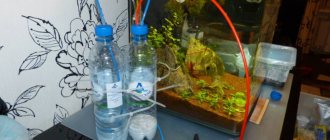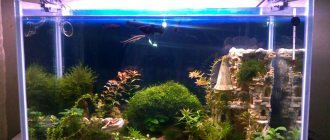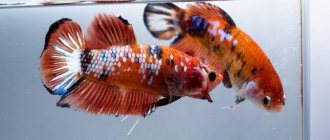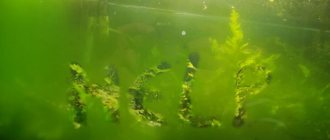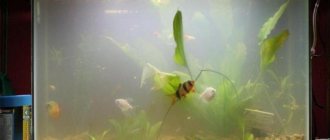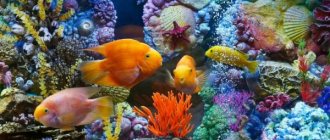A home artificial pond is a complex system in which the biological balance is maintained artificially. Cleaning a reservoir is one of the ways to maintain cleanliness and biological balance. If an aquarium with fish is not cleaned correctly, the water inside the vessel may become cloudy and dry out. Therefore, the aquarium should be washed, taking into account all the subtleties and requirements, in order to avoid many ailments and preserve the health of the inhabitants. The article will help novice aquarists understand how to properly clean an aquarium without harming the fish.
Why do you need to wash and clean your aquarium?
Cleaning the aquarium is vital for all living organisms inside the reservoir. Contaminants appear on all surfaces: soil, bottom, wall, plants and decor, and the filter also becomes dirty. Plaque and debris appear as a result of the vital activity of the inhabitants, who excrete feces, the remains of uneaten food and the active growth of algae. Regardless of the size, large and small aquariums equally need washing; if the procedure is regular, then washing the vessel will not be difficult, since there will not be time for heavy contamination to form.
Adviсe
- Unnecessary manipulations interfere with the life of the inhabitants of the reservoir, so you should only get into it if necessary. 3-4 days before cleaning, reduce the length of daylight in the aquarium (to 6-7 hours) and do not feed the fish on the day of the procedure. Cleaning equipment must be separate for each aquarium.
- Experienced aquarists advise keeping as few snails as possible and as many Ancistrus and Otocinclus as possible. The latter play the role of aquarium cleaners: they move along the walls and do not allow plaque to take hold.
- In addition, to prevent the formation of a limescale film, the filter exhaust should be directed at a slight angle along the front glass to form a constant wave. It also prevents the formation of water stone.
How often should you clean your aquarium?
Cleaning the aquarium should be carried out depending on the rate of plaque formation, which, in turn, directly depends on the population density inside the reservoir, as well as on the species of fish. Usually the aquarium is washed 1-2 times a week. The presence and number of living plants also significantly influences the frequency of cleaning. Vegetation absorbs nitrates and nitrites well, reducing the need to clean the vessel.
Signs indicating that the container needs to be washed:
- Plaque on the walls.
- Plaque on the surface of plants and decorative items.
- A slight movement of fish near the substrate contributes to the rise of turbidity.
It should be noted that under such conditions, water parameters do not change much, so there is no urgent threat to the lives of the inhabitants. However, if the water inside the vessel begins to change color, cleaning is necessary urgently.
Plaque on the walls
Folk remedies
If special chemicals are not available, there is always the option of using cleaners prepared at home from improvised materials. The most popular products for decalcification remain acid-rich lemon and vinegar, to which ammonia is often added:
- instead of fresh lemon, citric acid is often used, it is also effective against calcium deposits; to prepare a solution, 20 grams of the substance are diluted in a glass of water and stirred until completely dissolved;
- vinegar, composition similar to 200 grams of water, tablespoon of product with 9% concentration, for application you can use a spray bottle or a clean cloth;
- ammonia, alcohol is diluted in a ratio of 1:10 and mixed thoroughly, the application procedure is the same;
- Another effective folk option is the use of peroxide, the substance is diluted in a ratio of 30 ml per 100 water.
The application procedure differs little from that described above. Since all compositions are prepared in the form of liquid solutions for application, it is most convenient to use spray bottles.
Important! Some types of household cleaners can be a burn hazard; for example, when working with vinegar-based solutions, it is recommended to protect your hands with gloves.
OXIDATOR IN THE AQUARIUM: WHAT IS IT AND HOW DOES IT WORK? WE DO IT WITH OUR OWN HANDS
WHY ARE AQUARIUM TESTS NEEDED?
10 COOL INTERNAL FILTERS FOR AQUARIUM.
How to clean an aquarium
To properly clean the inside of the vessel, it should be washed using special equipment.
Necessary tools and accessories to clean the aquarium:
- Glass scraper for removing plaque and algae.
- Soil cleaner – siphon.
- Bucket or bowl.
- Net.
The scraper must be selected according to the type and size, relative to the type of aquarium. The most expensive and convenient option is a magnetic scraper that collects dirt by running along the outside of the wall. The pond can be washed with a regular sponge, without impregnation with cleaning agents.
Cleaning equipment
Not all available cleaning products can be used to clean an aquarium. Some of them can even harm fish. Several items are used for cleaning:
- Scraper: It is best to buy a magnetic one, designed for aquariums. You just need to immerse it in water and control the movements from the other side of the glass. Your hands will remain dry.
- Siphon: purchased at a specialized store or made independently from a hose.
- Filter: works constantly. It cleans walls, algae, and soil. It filters water without stopping. Thanks to this, the aquarium is less polluted.
Washing and cleaning a new aquarium
A new aquarium also requires cleaning. However, you should not wash the vessel so thoroughly for the first time. A small container can be rinsed with running water in the bath, where it will be as convenient as possible. It is recommended to rinse the aquarium with not hot water, using a sponge. Water that is too hot can damage the glass walls of the vessel.
New aquarium
If there is any doubt about the cleanliness of the vessel, then you can use baking soda, it is not recommended to use soap, and before starting the vessel you need to make sure that all particles of the cleaning agent are washed off. To do this, the aquarium is rinsed at least 4 times under strong pressure. When cleaning is completed, the aquarium must be rinsed with clean, chlorine-free water. To do this, tap water should be allowed to stand for several days.
The purchased substrate also needs to be washed. The soil is washed without the use of chemicals until the water becomes clear. The new filter also needs to be thoroughly washed. All decorative items are also washed, but using baking soda.
Special means
This category includes specially developed cleaning compounds. These can be impregnated wipes, sprays or solutions. They allow you to clean without harming flora and fauna. To this list you need to add softeners, which allow you to remove traces of calcium without replanting the inhabitants and draining the water. An example of such means is:
- Tetratec is a set of wipes impregnated with components that dissolve lime and green deposits;
- Aquarium Pharmaceuticals Safe and Easy, spray for cleaning glass and acrylic surfaces from traces of calcification;
- Aquayer, one of the softeners, when placed in the filter neutralizes calcium salts, reduces the level of hardness, is not recommended for long-term use, after 45 minutes it should be removed from the filter.
The first two options require completely emptying the container. After draining and replanting the fish and plants, the walls of the container are treated with the selected product, left for a few minutes, then the chemicals along with any remaining contaminants are washed off with running water.
Important! Despite the advertised safety of special compounds, after treating the internal cavity with them, the remaining substances must be completely washed off. Its accumulation can harm aquarium inhabitants.
How to properly clean an aquarium
It is important to clean an aquarium with and without fish by following certain rules, regardless of whether the pond is large or small. If the cleaning sequence is disrupted, it will be difficult to achieve proper cleanliness. Regular cleaning is necessary to maintain the natural balance of beneficial bacteria and harmful ones.
The procedure for cleaning an artificial reservoir:
- Removing algae and bacteria deposits from glass.
- Cleaning decorative elements and stones.
- Thinning of living plants.
- Removing rotten leaves on plants.
- Soil siphon for eliminating waste.
- Partial drainage of water.
- Cleaning and washing filters.
- Top up with clean water.
Home care methods
We clean the glass from plaque and greens with a sponge, a brush, a magnet and a scraper
First of all, always clean the walls of the aquarium, which very often become covered with brown or green spots. This can be done with various devices, in particular scrapers.
Such devices are especially relevant in the presence of large-volume aquariums. There are three types of scrapers :
- A scraper with a soft, sponge-like surface. It has a long handle and is convenient for cleaning glass in medium-sized containers.
- Metal scrapers. The design includes a special knife for aquarium glass. Often there are double-sided models, with a sponge on the back side.
- Magnetic scrapers. Consist of two parts, with built-in strong magnets. Such devices are very convenient, but remember that they should be used with extreme caution. One grain of sand caught under the scraper and the walls of the aquarium will be irreversibly scratched.
Most often, they wash the walls using ordinary dish sponges. The hard side of such a sponge will help wash away heavy dirt, while the main dirt will be easily washed off with the soft side.
Another thing that is indispensable when cleaning an aquarium is an ordinary toothbrush . It allows you to thoroughly wash seams and objects with small parts.
Important! If your aquarium “goes green” too often, eliminate the cause of the intense growth of algae: resettle the fish, reduce the amount of light entering the pond, change the water more often.
We clean the bottom with a siphon, and without it
Cleaning the soil is the most labor-intensive process. In the first month after moving in, it is not necessary to wash it, but over time, pollutants accumulate in the soil - particles of food, fish feces, which begin to rot and release hydrogen sulfide, which is toxic to aquatic life.
This procedure can be carried out in two ways:
- Using a siphon.
Using a cylinder - a funnel, stir up the soil, this will lift contaminants from the bottom and draw them into the siphon with the flow. Heavy soil will quickly fall into place. After clean water begins to appear from the pump tip, move on to the next section of soil.
After treating the entire surface, add fresh water. In the first hours it will be somewhat cloudy, but soon the suspension will settle and transparency will return.
And yes, siphons also have an automatic battery-powered model.
ATTENTION! If the entire bottom is covered with plants, cleaning with a siphon is not carried out.
- Cleaning without using a siphon is carried out for various reasons. The main ones are severe pollution and an abundance of algae in the aquarium.
In case of severe contamination, it is necessary to completely remove the soil and rinse it under running water. No need to use chemicals.
If you are not ready to buy a pump in a store, you can make it yourself. All you need is a hose and an empty bottle with the bottom cut off. The inconvenience of this design is the need to suck air out of the hose, just as car owners do when they need to drain gasoline from the tank.
Changing the water
Changing water is one of the most important procedures for caring for a home pond. If you regularly do not add fresh water, the fish will begin to get sick and die.
This event is carried out simultaneously with siphoning the soil and cleaning the walls of the aquarium. If these actions help eliminate visible contaminants, then changing the water is designed to reduce the level of nitrates and phosphates. In addition, clean water contains minerals necessary for the health of fish. Substitution allows you to replenish these substances and regulate the acidity of the water.
Replacement should be done every 7–10 days . However, remember that in densely populated aquariums this should be done somewhat more often.
Usually 20–30% of the volume is replaced, and in a marine aquarium no more than 15% of the water.
In the case of a partial replacement, it is not necessary to settle tap water - in such quantities, chlorine is not dangerous for the inhabitants of the reservoir.
Helper fish
For additional help in daily cleaning of the aquarium, you can get nurse fish. There are species of fish that feed on unicellular algae, thereby saving the artificial reservoir from unnecessary sedimentation of plaque. However, these pets are only helpers and begin to eat algae only when they feel hungry.
Ancistrus helper fish
In addition to fish, other animals in an artificial reservoir can also perform cleaning functions. Helpers in cleaning an aquarium:
- Gold fish.
- Corridor.
- Viviparous inhabitants.
- Ancistrus (sucker fish).
- Brocade catfish.
- Labeo.
- Gourami.
- Catfish otocinclus.
- Gyrinocheilus.
- Siamese algae eater.
- Snail.
- Shrimps.
Reasons for the appearance of greenery
Green plaque on the walls causes the development of a number of algae - green euglena, filamentous edogonium and xenococus. These algae envelop not only the walls of the vessel, but also soil stones and decorative elements. The algae development cycle is 3 weeks, during which time all spores settle on the walls of the tank. The green coating begins to lighten, and at this moment it is necessary to get rid of the spores, preventing the start of a new cycle.
The main causes of excessive development of green algae:
- Excessive lighting. The aquarium should not be located directly next to a window under the influence of direct sunlight; artificial lighting must be strictly regulated.
- Insufficient cleaning of glass, soil, plants. Spores lingering in the ground, in scratches on glass, on vegetation, contribute to the further proliferation of algae.
- Incorrect temperature setting.
- Untimely water replacement.
- High concentration of phosphates and nitrates as a result of untimely water replacement. As the liquid evaporates, the amount of salts in it increases; adding water instead of replacing it aggravates the situation.
- Excess food or unsuitable food, uneaten food remains settle to the bottom and begin to rot.
The age of the aquarium must be taken into account. In a new tank, the appearance of algae may be caused by the fact that the nitrogen cycle has not yet been established, or the aquarium plants are not sufficiently rooted. If a green coating appears in an old tank, most likely this is caused by a large amount of organic residues. It is necessary to check whether the filter is clogged. Having determined the causes of the problem, it will be easier for you to choose methods to combat it and remove greens from the aquarium.
Personal experience
An example of the successful use of improvised substances is the use of 70% acetic acid. In addition, cotton pads and half a razor blade were prepared. To clean glass walls
- the discs were periodically wetted with acid;
- areas of contamination were wiped;
- After wiping, areas with heavy deposits were additionally cleaned with a blade.
The surface is quickly cleaned; in most cases, the blade turned out to be superfluous. After the procedure, the internal cavity must be thoroughly washed. The acid is concentrated, even a minimal amount can harm flora and fauna.
Important! Acetic acid of this concentration gives a strong odor, so it is advisable to clean it in a well-ventilated area.

